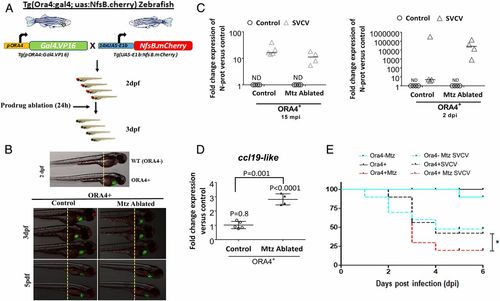- Title
-
Olfactory sensory neurons mediate ultrarapid antiviral immune responses in a TrkA-dependent manner
- Authors
- Sepahi, A., Kraus, A., Casadei, E., Johnston, C.A., Galindo-Villegas, J., Kelly, C., García-Moreno, D., Muñoz, P., Mulero, V., Huertas, M., Salinas, I.
- Source
- Full text @ Proc. Natl. Acad. Sci. USA
|
Ablation of crypt neurons results in increased susceptibility to rhabdoviral infection in zebrafish. (A and B) Schematic representation of the generation of ora4 transgenic zebrafish and ablation of crypt neurons by delivery of the prodrug metronidazole (Mtz) into the water for 24 h. (C) Expression of ccl19-like chemokine in whole zebrafish larvae 15 min after infection with SVCV, as measured by RT-qPCR. Each symbol represents a pool of 10 larvae. Results are expressed as the fold change in expression compared with uninfected controls. Expression levels were normalized to the rps11 as housekeeping gene. Data are expressed as the mean fold change compared with the control group using the Pfaffl method. Results are representative of three different experiments (n = 5). Results were analyzed by unpaired t test. (D) Relative SVCV viral loads as measured by N protein expression levels 15 min and 2 d after SVCV infection in ORA4+ zebrafish and ORA4+ + Mtz (ablated) zebrafish. Each symbol represents a pool of 10 larvae. Results are expressed as mean level of N protein expression measured by RT-qPCR compared with uninfected controls. ND, nondetectable. P values were obtained by unpaired t test. (E) Percent survival of wild-type (ORA4−) and transgenic (ORA4+) zebrafish larvae that were ablated (+Mtz) or not in response to SVCV infection. Results are representative of two independent experiments (n = 30 per group). The asterisk indicates statistically significant differences between groups. Statistical analysis was performed by the Gehan–Breslow–Wilcoxon method (P < 0.05). PHENOTYPE:
|

